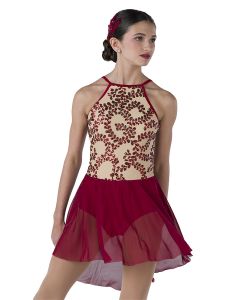Introduction: Where Art Meets Athleticism
Acro dance is a breathtaking fusion of classical dance techniques and acrobatic elements. Imagine the grace of ballet meeting the athleticism of gymnastics — that’s acro. From slow, fluid movements to jaw-dropping aerial flips, this style demands not only immense skill but also the right gear to make it happen. At the heart of that gear? Acro dance costumes.
A costume in acro dance is far more than a visual treat. It’s a carefully designed tool that enhances flexibility, supports complex movements, and tells a story on stage. The wrong outfit can limit motion, cause discomfort, or even lead to performance mishaps. The right one? It becomes part of the performance itself, enabling seamless movement and helping dancers feel unstoppable.
Why Costumes Matter in Acro Dance
In acro, the costume has to handle a unique set of challenges:
- Full Range of Motion – Backbends, aerials, handsprings, and partner lifts require unrestricted movement.
- Durability – With constant contact against floors, mats, and sometimes partners, the fabric must withstand abrasion.
- Secure Fit – Loose costumes risk slipping or catching, which can be dangerous mid-performance.
- Visual Impact – While functionality is key, stage appeal can’t be ignored. The costume should complement the choreography and music.
Unlike in purely artistic dance styles, acro requires a perfect marriage of practicality and aesthetics.
Core Features of the Perfect Acro Dance Costume
A top-quality acro costume is defined by a combination of elements:
1. Stretch-Friendly Fabrics
Think Lycra, spandex, or stretch mesh. These materials allow dancers to move freely without the costume restricting their lines or tearing during an intense sequence.
2. Reinforced Seams
Acro costumes go through more strain than most dancewear. Reinforced stitching prevents embarrassing mid-routine malfunctions.
3. Breathability and Comfort
Sweating is inevitable under stage lights. Lightweight, breathable fabrics help dancers stay cool and focused.
4. Strategic Coverage
Acro moves often involve upside-down positions. Costumes need to be designed to maintain modesty from all angles while keeping dancers confident.
5. Non-Restrictive Necklines and Armholes
Any element that cuts into the skin or limits extension is a no-go for acro. The upper body must be able to bend, twist, and extend freely.
Popular Styles for Acro Dance Costumes
While every acro routine is unique, certain costume styles are consistently popular for their blend of form and function:
1. Unitards
Full-body unitards are a favorite for acro routines because they stay in place, reduce wardrobe malfunctions, and allow complete freedom of movement. They also create clean, uninterrupted body lines for a sleek stage look.
2. Leotard with Leggings
This two-piece option combines the stability of a leotard with the comfort of full-length leggings. It’s versatile for both dramatic and high-energy performances.
3. Crop Tops with High-Waisted Bottoms
For more contemporary acro routines, a fitted crop top paired with secure high-waisted shorts or pants can deliver a modern, dynamic appearance.
4. Mesh and Cut-Out Designs
When strategically placed, mesh inserts or cut-outs add visual flair without sacrificing support or coverage.
5. Theme-Based Costumes
For narrative-driven routines, costumes may incorporate elements like capes, skirts, or printed designs — as long as they don’t interfere with tumbling and lifts.
Color and Design Choices
In acro dance, color isn’t just decoration — it’s part of the storytelling.
- Bold Colors like red, gold, or royal blue are powerful for energetic, high-impact routines.
- Soft Pastels like lavender or blush can complement lyrical acro performances.
- Monochrome Schemes create elegance and allow choreography to shine without distraction.
- Metallic Accents catch stage lights beautifully, adding depth and sparkle.
Designs should also consider how the costume looks under stage lighting. A color that pops in rehearsal might look washed out on stage if not chosen carefully.
Safety Considerations in Acro Dance Costumes
A costume can look incredible, but if it’s not safe, it doesn’t belong in an acro routine. Safety factors include:
- No Loose Straps or Dangling Accessories – These can catch during flips or lifts.
- Slip-Resistant Fabrics – For partner work, materials should offer enough grip to prevent hands from slipping.
- Secure Closures – Zippers, snaps, and hooks must be tested before performance day.
- Minimal Bulk – Excess fabric can interfere with floor work or landings.
Customization: Tailoring Costumes to the Routine
The most successful acro performances often feature custom costumes designed specifically for the choreography. This ensures every movement flows without distraction. Customization can include:
- Adjusting hem lengths for floor rolls.
- Adding extra stretch panels for flexibility.
- Choosing fabrics that match the theme of the music.
- Embellishing with rhinestones or sequins in durable placements.
Custom costumes also give the performance a professional, polished edge that stands out in competitions.
Maintaining Acro Dance Costumes
Because acro costumes are investments, proper care is essential:
- Hand Wash Only – Machine washing can stretch or damage delicate fabrics.
- Air Dry Flat – Avoid dryers to prevent shrinkage or melting of synthetic materials.
- Store Separately – Keep away from velcro or sharp items that can snag the costume.
- Check Before Each Use – Look for loose threads or worn elastic and repair immediately.
Trends in Acro Dance Costumes for 2025
As dance fashion evolves, so do acro costume trends:
- Minimalist Aesthetics – Sleek, solid colors with clean lines are gaining popularity.
- Eco-Friendly Fabrics – Sustainable, recycled materials are making their way into dancewear.
- High-Tech Fabrics – Moisture-wicking, anti-slip, and compression fabrics are becoming standard for high-performance routines.
- Integrated Accessories – Built-in arm cuffs, attached skirts, or integrated gloves for character-driven routines.
Choosing the Right Costume Supplier
When selecting a costume supplier for acro dance:
- Look for Specialization in Acro or Gymnastics Wear – These companies understand the performance demands.
- Read Reviews – Dancers’ experiences can reveal quality and durability.
- Request Fabric Samples – Testing stretch and feel before purchase prevents costly mistakes.
- Ask About Custom Fitting – Perfect fit is non-negotiable in acro.
Final Thoughts: The Costume as a Partner in Performance
In acro dance, the costume isn’t just an outfit — it’s a silent partner in every leap, twist, and landing. It supports the dancer’s body, enhances visual storytelling, and ensures safety on stage. Whether you choose a sleek unitard, a bold themed look, or a minimalist design, the right costume transforms a great performance into an unforgettable one.
Investing time in selecting or designing the perfect acro dance costume pays off in confidence, performance quality, and audience impact. Because in the world of acro, every detail — from the pointed toe to the sparkle of a rhinestone — tells part of the story.



